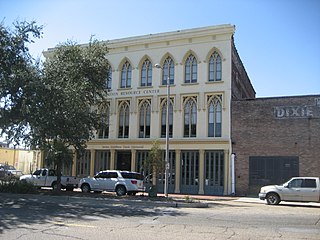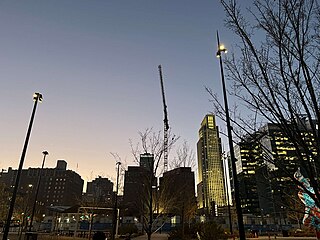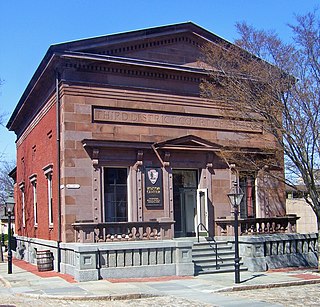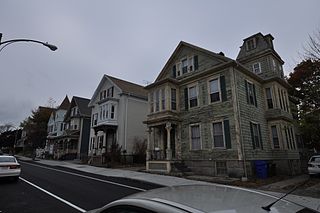
New Bedford is a city in Bristol County, Massachusetts, United States. It is located on the Acushnet River in what is known as the South Coast region. Up through the 17th century, the area was the territory of the Wampanoag Native American people. English colonists bought the land on which New Bedford would later be built from the Wampanoag in 1652, and the original colonial settlement that would later become the city was founded by English Quakers in the late 17th century. The town of New Bedford itself was officially incorporated in 1787.

Charles W. Morgan is an American whaling ship built in 1841 that was active during the 19th and early 20th centuries. Ships of this type were used to harvest the blubber of whales for whale oil which was commonly used in lamps. Charles W. Morgan has served as a museum ship since the 1940s and is now an exhibit at the Mystic Seaport museum in Mystic, Connecticut. She is the world's oldest surviving (non-wrecked) merchant vessel, the only surviving wooden whaling ship from the 19th century American merchant fleet, and second to the USS Constitution, the oldest seaworthy vessel in the world. The Morgan was designated a National Historic Landmark in 1966.

New Bedford Whaling National Historical Park is a United States National Historical Park in New Bedford, Massachusetts, and is maintained by the National Park Service (NPS). The park commemorates the heritage of the world's preeminent whaling port during the nineteenth century.

The New Bedford Whaling Museum is a museum in New Bedford, Massachusetts, United States that focuses on the history, science, art, and culture of the international whaling industry, and the colonial region of Old Dartmouth in the South Coast of Massachusetts. The museum is governed by the Old Dartmouth Historical Society (ODHS), which was established in 1903 "to create and foster an interest in the history of Old Dartmouth." Since then, the museum has expanded its scope to include programming that addresses global issues "including the consequences of natural resource exhaustion, the diversification of industry, and tolerance in a multicultural society." Its collections include over 750,000 items, including 3,000 pieces of scrimshaw and 2,500 logbooks from whaling ships, both of which are the largest collections in the world, as well as five complete whale skeletons. The museum's complex consists of several contiguous buildings housing 20 exhibit galleries and occupying an entire city block within the New Bedford Whaling National Historical Park, although operated independently.

Monterey State Historic Park is a historic state park in Monterey, California. It includes part or all of the Monterey Old Town Historic District, a historic district that includes 17 contributing buildings and was declared a National Historic Landmark in 1970. The grounds include California's first theatre, and the Monterey Custom House, where the American flag was first raised over California.

The Georgia Trust for Historic Preservation is the United States' largest statewide, nonprofit preservation organization with more than 8,000 members. Founded in 1973 by Mary Gregory Jewett and others, the Trust is committed to preserving and enhancing Georgia's communities and their diverse historic resources for the education and enjoyment of all.

Shockoe Bottom historically known as Shockoe Valley, is an area in Richmond, Virginia, just east of downtown, along the James River. Located between Shockoe Hill and Church Hill, Shockoe Bottom contains much of the land included in Colonel William Mayo's 1737 plan of Richmond, making it one of the city's oldest neighborhoods.

The Preservation Resource Center is a non-profit organization which promotes the historic preservation of buildings and architecture in New Orleans.

Downtown Omaha is the central business, government and social core of the Omaha–Council Bluffs metropolitan area, U.S. state of Nebraska. The boundaries are Omaha's 20th Street on the west to the Missouri River on the east and the centerline of Leavenworth Street on the south to the centerline of Chicago Street on the north, also including the CHI Health Center Omaha. Downtown sits on the Missouri River, with commanding views from the tallest skyscrapers.

The East End Historic District in Newburgh, New York, United States is the lower portion of what state and city officials recognize as a single historic district along with the Montgomery-Grand-Liberty Streets Historic District. Its 445 acres (2 km2) contain 2,217 buildings, including Washington's Headquarters State Historic Site, a National Historic Landmark.

The William Rotch Jr. House, now the Rotch–Jones–Duff House and Garden Museum, is a National Historic Landmark at 396 County Street in New Bedford, Massachusetts, in the United States. The three families whose names are attached to it were all closely tied to the city's nineteenth-century dominance of the whaling industry. Because of this, the house is part of the New Bedford Whaling National Historical Park.

The New Bedford Historic District is a National Historic Landmark District in New Bedford, Massachusetts, United States, west of the community's waterfront. During the 19th century, when the city was the center of the American whaling industry, this was its downtown. After its decline in the early and mid-20th century, through the efforts of local activist groups the district has since been preserved and restored to appear much as it was during that period.

The Old Third District Courthouse in New Bedford, Massachusetts, United States, is located at the corner of Second and William streets. It was built in 1853 by Russell Warren in the Greek Revival architectural style, as the home of the New Bedford Institute for Savings, a local bank. After the bank moved, the Bristol County courts came in. They, too, eventually outgrew it and moved elsewhere in the city. Since the creation of New Bedford Whaling National Historic Park in 1996, it has been used by the National Park Service (NPS) as the park's visitor center.

The North Bedford Historic District is a historic district roughly bounded by Summer, Parker, Pleasant and Kempton Streets in New Bedford, Massachusetts. It encompasses a predominantly residential neighborhood north of downtown New Bedford which was developed primarily in the mid 19th-century. It features a variety of worker housing of the period, as well as a number of higher quality houses built by businessmen. The district was added to the National Register of Historic Places in 1979.

The Micanopy Historical Society Museum is located at 607 Northeast 1st Avenue, Micanopy, Florida, United States. It contains materials relating to the history of the town. It is part of the Micanopy Historic District, which is listed on the National Register of Historic Places.

The United States Customhouse is a historic and active custom house at 2nd and William Streets in New Bedford, Massachusetts. Architect Robert Mills designed the custom house in 1834 in a Greek Revival style. It has been used by the U.S. Customs Service ever since, and today serves as a port of entry.

Save Our Heritage Organisation (SOHO) is a non-profit organization devoted to the preservation of the historic architecture and landmarks around the San Diego, California area. Founded in 1969, Save Our Heritage Organisation maintains several historic buildings including the Whaley House and the George W. Marston House. They are directly partnered with the National Trust for Historic Preservation.
Scenic Hudson is a non-profit environmental organization in New York that was founded in 1963 to oppose a hydro-electric power project in New York.

Antoinette Forrester Downing was an American architectural historian and preservationist who wrote the standard reference work on historical houses in Rhode Island. She is credited with spearheading a movement that saved many of Providence's historic buildings from demolition in the mid 20th century and for her leadership was inducted into the Rhode Island Heritage Hall of Fame in 1978.
The Elihu Akin House is a house in Dartmouth, Massachusetts, United States. It was built in 1762 by carpenter Jon Mosher. The house was later owned by the Akins, who were a prominent local family; Elihu Akin moved into the house after his own former home had been burnt in Grey's raid during the American Revolutionary War. At the start of the 21st century, the house was extensively renovated. The Dartmouth Heritage Preservation Trust and the town of Dartmouth now own the house.


















